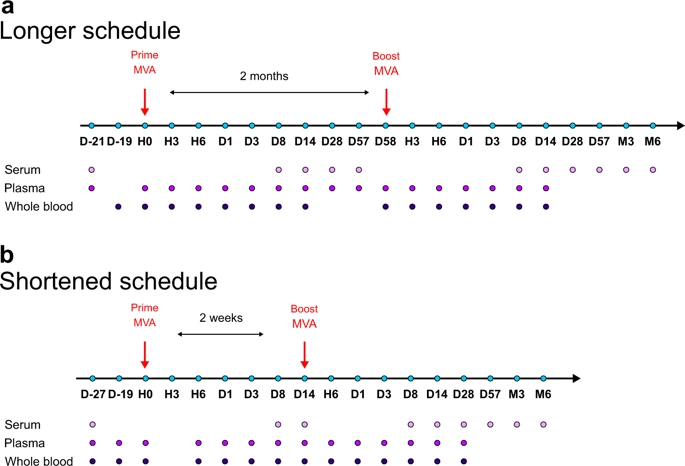npj Vaccines ( IF 6.9 ) Pub Date : 2020-03-19 , DOI: 10.1038/s41541-020-0175-8 Jean-Louis Palgen 1, 2 , Nicolas Tchitchek 1, 2 , André Rodriguez-Pozo 1, 2 , Quentin Jouhault 1, 2 , Hadjer Abdelhouahab 1, 2 , Nathalie Dereuddre-Bosquet 1, 2 , Vanessa Contreras 1, 2 , Frédéric Martinon 1, 2 , Antonio Cosma 1, 2 , Yves Lévy 2, 3 , Roger Le Grand 1, 2 , Anne-Sophie Beignon 1, 2

|
Comprehending the mechanisms behind the impact of vaccine regimens on immunity is critical for improving vaccines. Indeed, the time-interval between immunizations may influence B and T cells, as well as innate responses. We compared two vaccine schedules using cynomolgus macaques immunized with an attenuated vaccinia virus. Two subcutaneous injections 2 weeks apart led to an impaired secondary antibody response and similar innate myeloid responses to both immunizations. In contrast, a delayed boost (2 months) improved the quality of the antibody response and involved more activated/mature innate cells, induced late after the prime and responding to the recall. The magnitude and quality of the secondary antibody response correlated with the abundance of these neutrophils, monocytes, and dendritic cells that were modified phenotypically and enriched prior to revaccination at 2 months, but not 2 weeks. These late phenotypic modifications were associated with an enhanced ex vivo cytokine production (including IL-12/23 and IL-1β) by PBMCs short after the second immunization, linking phenotype and functions. This integrated analysis reveals a deep impact of the timing between immunizations, and highlights the importance of early but also late innate responses involving phenotypical changes, in shaping humoral immunity.
中文翻译:

通过增加 MVA 疫苗免疫之间的时间来改善先天性和继发性体液反应
理解疫苗方案对免疫的影响背后的机制对于改进疫苗至关重要。事实上,免疫接种之间的时间间隔可能会影响 B 和 T 细胞,以及先天反应。我们比较了使用减毒痘苗病毒免疫的食蟹猴的两种疫苗计划。相隔 2 周的两次皮下注射导致二次抗体反应受损,并且对两种免疫的先天性骨髓反应相似。相比之下,延迟加强(2 个月)提高了抗体反应的质量,并涉及更多活化/成熟的先天细胞,在初免后较晚被诱导并对召回作出反应。二抗反应的强度和质量与这些中性粒细胞、单核细胞、和树突状细胞,在 2 个月而不是 2 周重新接种之前,表型发生改变并富集。这些晚期表型修饰与第二次免疫后不久 PBMC 增强的体外细胞因子产生(包括 IL-12/23 和 IL-1β)相关,将表型和功能联系起来。这种综合分析揭示了免疫时间之间的深刻影响,并强调了早期和晚期先天反应在塑造体液免疫方面的重要性,包括表型变化。











































 京公网安备 11010802027423号
京公网安备 11010802027423号